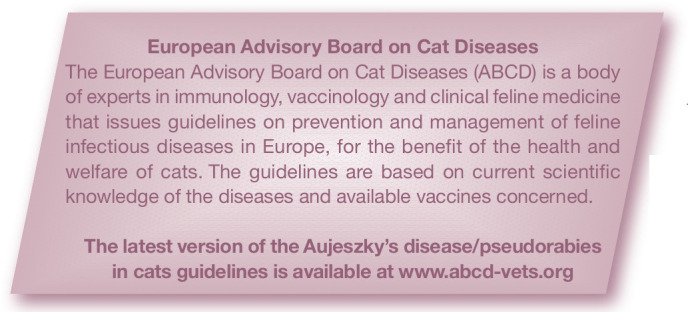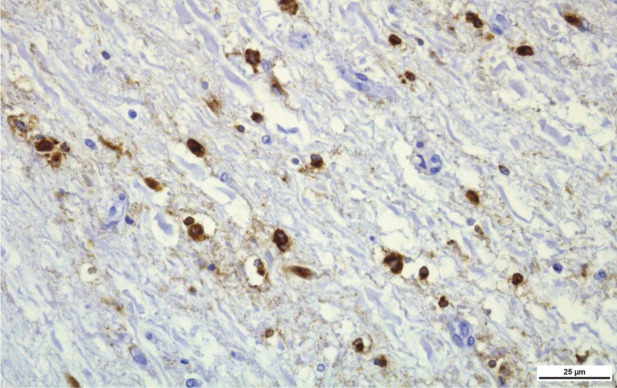Abstract
Overview: Although pseudorabies in swine – Aujeszky’s disease – has been eradicated from many pork-producing countries, the virus may still lurk in other vertebrate species and cause feline cases. Infection occurs through the ingestion of uncooked meat and organ material and presents as an acute encephalitis with a short incubation period and a rapidly fatal outcome. The ABCD considers this reason enough to include a review of this, now very rare, condition in this Special Issue.
Virus
Aujeszky’s disease/pseudorabies is caused by suid herpesvirus 1, belonging to the genus Varicellovirus in the subfamily Alphaherpesvirinae, family Herpesviridae, order Herpesvirales.
Epidemiology
Transmission of Aujeszky’s disease virus in cats occurs mainly through the ingestion of raw pork, and particularly pork lungs or pig offal. It can also be indirect, following viral excretion by pigs and, therefore, in the absence of contacts with pigs. In the case of Aujeszky’s disease outbreaks in other species, such as sheep, feline cases have also been observed. 1

The disease has been eradicated in pigs in several European countries, and there is no longer a risk of Aujeszky’s disease virus transmission to cats. However, the prevalence of Aujeszky’s disease virus infection in wild boar can be high in western European countries, and Aujeszky’s disease is still sporadically observed in hunting dogs. This peculiar epidemiological situation does not represent an increased risk of infection for cats.
Pathogenesis
The virus enters via the oral route and replicates in the tonsils and the pharynx. It spreads through the central nervous system via the cranial nerves (Figure 1) and is excreted with oral and nasal secretions. However, this excretion has no epidemiological consequences, since the cat does not transmit the virus.
Figure 1.
Immunoperoxidase staining of a brain section from a dog that had died from Aujeszky’s disease. Infected cells show a brownish precipitate. Courtesy of Professor Pumarola, Universitat Autňnoma de Barcelona, Spain
Clinical signs
This disease is encountered sporadically, mainly in urban cats fed pig offal. As in dogs, the incubation period is short, lasting for 2–4 days. The infection causes acute encephalitis, the initial clinical signs of which are excitation and hypersalivation. The cat presents with anorexia, sometimes with intense pruritus, which leads to lesions due to scratching and self-mutilation. More copious salivation ensues, and the nervous signs become more pronounced, with a lack of coordination and paralysis. When this clinical picture is observed, it may be mistaken for rabies. However, cats that develop Aujeszky’s disease are rarely aggressive, and disease progression is more rapid than in rabies. The outcome is invariably fatal, within 12–48 h of the onset of clinical signs. 2
Diagnosis
A polymerase chain reaction developed for the detection of Aujeszky’s disease virus in pigs can be used on brain and lung tissue homogenates from cats. However, when clinical signs of encephalitis are seen in cats (pseudorabies), the differential diagnosis of rabies must always be ruled out.
Disease management
No treatment is possible with this deadly disease.
Control
Attenuated Aujeszky’s disease virus vaccines have been developed to protect pigs, but these are still virulent for carnivores, including cats. Only inactivated or subunit vaccines are safe, but they unfortunately have not demonstrated any efficacy against Aujeszky’s disease in cats. Infection of cats (and dogs) can be prevented by cooking meat or pork offal, by feeding commercial pet food, and avoiding contact with infected pigs. 3
Footnotes
Funding: The authors received no specific grant from any funding agency in the public, commercial or not-for-profit sectors for the preparation of this article. The ABCD is supported by Merial, but is a scientifically independent body.
The authors do not have any potential conflicts of interest to declare.
Key Points
Aujeszky’s disease virus is a swine herpesvirus that can be transmitted to cats mainly through the ingestion of raw pork.
Aujeszky’s disease in cats presents as an acute encephalitis with a short incubation period and a rapidly fatal outcome.
Prevention of infection relies on cooking meat or pork offal or, better still, using commercial pet food, as well as avoiding contact with infected pigs.
References
- 1. Henderson JP, Graham DA, Stewart D. An outbreak of Aujeszky’s disease in sheep in Northern Ireland. Vet Rec 1995; 136: 555–557. [DOI] [PubMed] [Google Scholar]
- 2. Maes L, Pensaert M. Pseudorabies virus (Aujeszky’s disease). In: Appel MJ. (ed). Virus infections of carnivores. Amsterdam: Elsevier Science, 1987, pp 241–246. [Google Scholar]
- 3. Thiry E. Aujeszky’s disease. In: Clinical virology of the dog and cat. Reuil-Malmaison, France: Editions du Point Vétérinaire, Wolters-Kluwer, 2006, pp 125–126. [Google Scholar]



